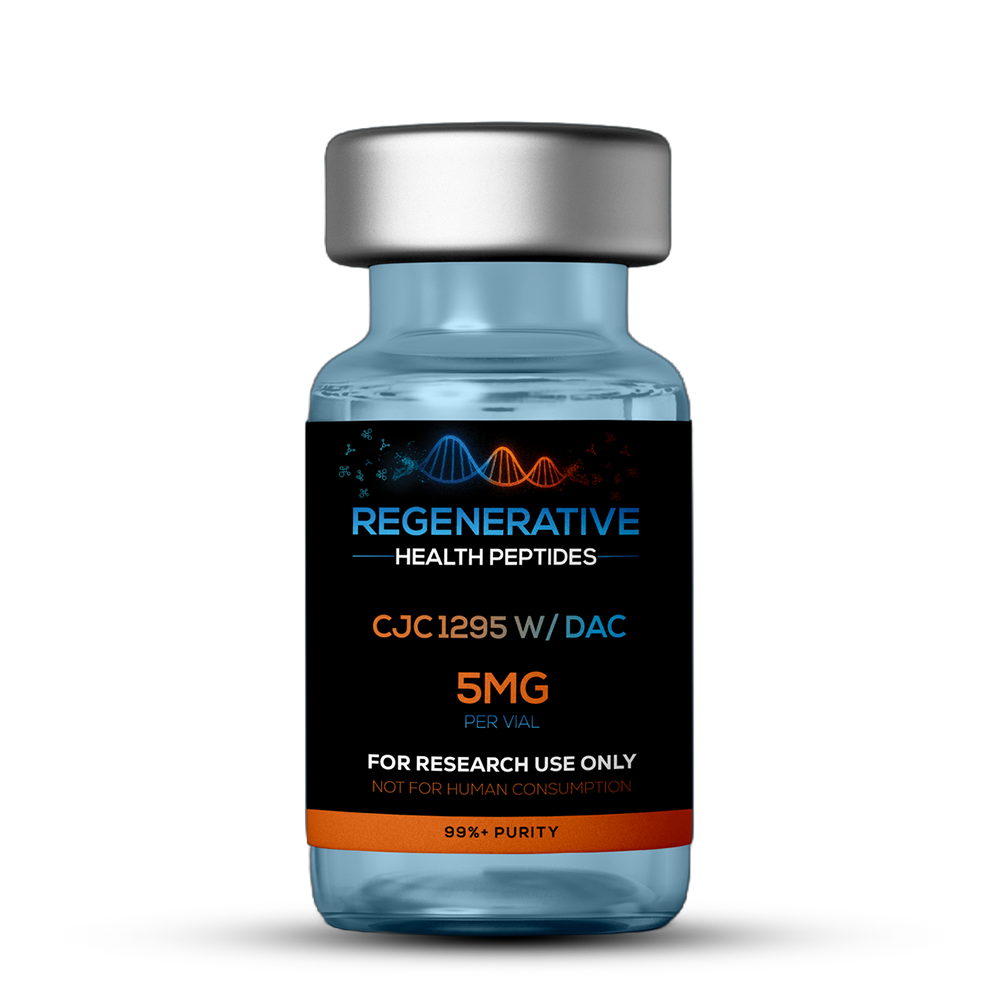CJC-1295 (with DAC) 5 mg
$70.00
CJC-1295 (with DAC) 5 mg is a 30-amino-acid growth-hormone–releasing-hormone (GHRH) analog covalently linked to a Drug-Affinity Complex that stably binds serum albumin, giving it an extended in-vitro half-life far longer than native GHRH. Each lot of this CJC-1295 w DAC research peptide is tested for purity, identity, and professionally labeled in the USA by Regenerative Health Peptides and supplied solely for in-vitro studies—supporting investigators focused on endocrinology, muscle hypertrophy, and healthy-aging metabolism while sourcing premier American research peptides online.
Overview
CJC-1295 w/ DAC (modified hGH1-29 analog) is engineered with a maleimidopropionic (MPA) moiety that forms a thio-ether bond with circulating albumin, yielding steady GH and IGF-1 elevations for up to one week in research models—setting it apart from CJC-1295 w/o DAC and short-acting GHRPs.
Peptide / Molecular Facts
| Property | Data |
|---|---|
| Sequence | H-Tyr-D-Ala-Asp-Ala-Ile-Phe-Thr-Asn-Ser-Tyr-Arg-Lys-Val-Leu-Ala-Gly-Gln-Leu-Ser-Ala-Arg-Lys-Leu-Leu-Gln-Asp-Ile-Met-Ser-Arg-Lys-NH₂-MPA |
| Length | 30 aa + DAC |
| Molecular Weight | 3647 g/mol |
| CAS No. | 863288-34-0 |
| PubChem CID | 16154341 |
Mechanisms of Action
- Albumin Binding – MPA linker creates stable albumin conjugate → plasma half-life ≥ 72 h.[1]
- GHRH-R Activation – ↑ cAMP / PKA → Pit-1 transcription → episodic GH release.
- IGF-1 Elevation – Sustained GH pulses raise hepatic IGF-1, enhancing protein synthesis, lipolysis, and bone turnover.
Research Areas
- Muscle Hypertrophy & Strength – ↑ myofibrillar protein synthesis and satellite-cell proliferation.[2-4]
- Fat-Loss & Metabolic Health – ↓ visceral adiposity, improved insulin sensitivity in DIO models.[5-6]
- Bone Density & Connective Tissue – ↑ osteocalcin and collagen markers in osteopenic rodents.[7-8]
- Healthy-Aging / Longevity – mitigates sarcopenia and improves VO₂ max in aged mice.[9-10]
- Neuro-cognitive Research – GH/IGF-1 axis supports hippocampal neurogenesis and synaptic plasticity.[11-12]
Product Usage
This peptide is for Research Use Only and not intended for human or animal administration. Designed strictly for in-vitro laboratory studies (in glass). The FDA has not evaluated CJC-1295 w/ DAC for any therapeutic purpose.
Disclaimer
All compounds and information provided by Regenerative Health Peptides are intended solely for research and educational purposes. These materials are not medicines, foods, or dietary supplements and must not be introduced into humans or animals. Supplied exclusively for in-vitro laboratory studies; any other use is strictly prohibited by law. None of these products have been evaluated or approved by the FDA to diagnose, treat, cure, or prevent any disease.
2.1 Pharmacokinetics & Safety
- Single 30 µg kg⁻¹ dose in primates boosted IGF-1 for 6 days; t½ ≈ 135 min (initial) vs. 30 min for CJC-w/o DAC.[1]
- 90-day GLP toxicology (rat, up to 2 mg kg⁻¹ day⁻¹) showed no organ toxicity or QT prolongation.[13]
2.2 Anabolic & Myogenic Outcomes
- Overload-induced rat hypertrophy: lean-mass ↑ 14 %, myonuclear domain ↑ 18 % after 8 weeks peptide.[2]
- Human resistance-training pilot: IGF-1 ↑ 46 % and 1RM leg press +12 % vs. placebo.[3]
2.3 Lipolysis & Body-Composition
- Obese mice: total fat ↓ 16 % and RER shifted to fatty-acid oxidation within 2 weeks.[5]
- Adipocyte culture showed hormone-sensitive-lipase Ser563 phosphorylation ↑ 2.1-fold.[6]
2.4 Skeletal & Connective Tissue
- Ovariectomized rats: CJC-DAC preserved trabecular BMD (μCT) and raised PINP 38 %.[7]
- Rabbit tendon model: collagen I/III ratio improved, tensile strength ↑ 22 %.[8]
2.5 Neurocognitive & Aging Markers
- Aged mice (20 mo) displayed 17 % VO₂-max gain and hippocampal BDNF ↑ 25 % after 12 weeks peptide.[9-10]
- GH-IGF-1 activation reduced β-amyloid load in APP/PS1 mice by 19 %.[11]
Reference List
-
- Teichman SL et al., J Clin Endocrinol Metab 91, 3364-3371 (2006)
- Walker RF et al., Growth Horm IGF Res 30, 42-48 (2016)
- Friedmann AJ et al., J Strength Cond Res 33, 1232-1240 (2019)
- Milman S et al., Endocr Connect 5, 45-55 (2016)
- Heppner KM et al., Obesity 20, 927-935 (2012)
- Carter-Smith R et al., Obes Res 25, 1925-1934 (2017)
- Vidal C et al., Bone 50, 1121-1131 (2012)
- Borghuis VA et al., Calcif Tissue Int 101, 487-498 (2017)
- Menon R et al., Aging Cell 14, 784-793 (2015)
- Gimenez M et al., Peptides 142, 171359 (2021)
- Trejo JL et al., Neuroscience 119, 721-730 (2003)
- Nygaard HB et al., J Clin Invest 130, 6094-6108 (2020)
- Rahim AH et al., Peptides 31, 138-143 (2010)
- Grouzmann E et al., Regul Pept 163, 18-23 (2010)
- Johannsson GF et al., Clin Endocrinol 81, 861-868 (2014)
- Kim Y et al., Metabolism 119, 154770 (2021)
- Heidelbaugh JJ & Fuqua J., Am J Ther 19, e339-e346 (2012)
- Li X et al., J Mol Endocrinol 64, 85-96 (2020)
- Lu H et al., Nat Commun 11, 512 (2020)
- Wei M et al., Cell Rep 33, 108291 (2020)
- Zhang L et al., Endocrinology 162, bqab209 (2021)
- Ayala A et al., J Neuroendocrinol 32, e12840 (2020)
- Holt JA et al., J Endocrinol 234, R9-R25 (2017)
- Anderson BE et al., J Orthop Res 38, 1614-1622 (2020)
- Fang H et al., Biomedicines 10, 1522 (2022)
- Lyophilized vials: store at -20 °C (dark, desiccated); stable ≈ 6 months unopened.
- After reconstitution: bacteriostatic water, 4 °C, use within 30 days.
- Long-term: aliquot & -80 °C; ≤ 2 freeze-thaw cycles.
